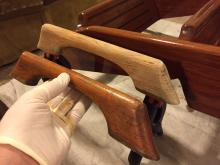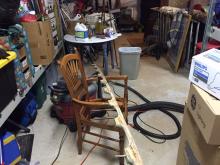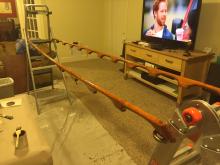While the boat is wrapped this winter, I removed the exterior handrails to sand down and refinish in the warmth of my basement. Very happy with the results. Will be reinstalling this weekend.
What is the best method of 1) cleaning the non-slip areas around the foot print of the handrails (removing 25 years of debris and varnish/Sikkens buildup) and 2) reinstalling the handrail? Would covering the bases of the handrails with butyl tape (aka - Maine Sail) be the best solution? I am worried that his tape would be too thick and not compress. Should caulk or another type of sealant be used? The temperature will probably be 40 F. While the holes through the deck are open, should these be coated with epoxy then redrilled? Lots of questions ....
Russell Green
S/V "GoodwiII" #759
1987 C36 MKI TR/WK M25XP
Moored: Deale, MD

[quote=down_shift]
What is the best method of 1) cleaning the non-slip areas around the foot print of the handrails (removing 25 years of debris and varnish/Sikkens buildup) and 2) reinstalling the handrail? Would covering the bases of the handrails with butyl tape (aka - Maine Sail) be the best solution? I am worried that his tape would be too thick and not compress.
... While the holes through the deck are open, should these be coated with epoxy then redrilled?[/quote]
I wish I could give you an answer for question #1. I've got the same issue, and have managed to clean off only some of that stuff with a combination of scraping, wire brushing, and even a dremel tool. Best not to make a mess there in the first place (One tip: do not leave varnish-soaked painters tape on the non-skip for months over the winter -- don't ask me how I know!).
As to question #2, I've been using butyl tape (from MaineSail) to do all above-waterline rebedding for the past few years, and one thing I can tell you is that you definitely need not worry about it not compressing. Indeed, that stuff will continue compressing for many months after you install it (and thus continue to very slowly bleed out the sides for months if you've used too much), so the trick is not to overdo it. That said, I would think it to be the best choice. Its not messy to apply like other materials, and allows for easy removal or resetting. It helps if you champher the top of the screw holes in the cabin roof to hold a small bead of butyl that you will wrap around the screw.
As to epoxying the holes, it depends on whether these is wood core in that area. On our 1985 Mk I I've yet to encounter wood core anywhere in the cabin roof -- either where there were existing holes or where I've added them (including a rather large one I cut to install a vent fan). I'm not saying there is none -- I don't know (documentation I've seen for models later than mine seems to indicate wood core in the cabin roof in some areas) -- just that I haven't encountered it.
Matthew Chachère
s/v ¡Que Chévere!
(Formerly 1985 C36 MKI #466 tall rig fin keel M25)
2006 Catalina Morgan 440 #30.
Homeported in eastern Long Island, NY
Thanks for the prompt re: sig line.



From another forum, this gentleman makes a good case for Dolfinite https://www.youtube.com/watch?v=GP7KS2knxn4&feature=youtu.be&t=13m
but I will use butyl tape as suggested. Good to know that it will continue to compress and I forgot about the ease of cleanup and removal. That compression was my primary concern given the cold temps and it would be a week or two before I could get back to the boat for a second round of tightening.
Four straight evenings of sanding, stripping, and laying down Cetrol. First coal of clear goes on tonight. The single hand rail I'm holding is what I started with.
Russell Green
S/V "GoodwiII" #759
1987 C36 MKI TR/WK M25XP
Moored: Deale, MD